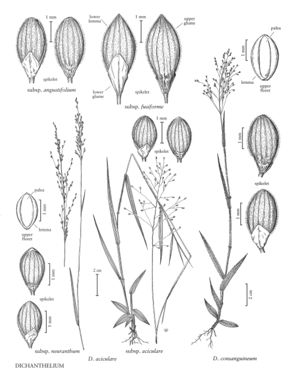Difference between revisions of "Dichanthelium aciculare subsp. neuranthum"
Synonyms: Panicum neuranthum
Treatment appears in FNA Volume 25. Treatment on page 444.
FNA>Volume Importer |
imported>Volume Importer |
||
| (4 intermediate revisions by 2 users not shown) | |||
| Line 6: | Line 6: | ||
|synonyms={{Treatment/ID/Synonym | |synonyms={{Treatment/ID/Synonym | ||
|name=Panicum neuranthum | |name=Panicum neuranthum | ||
| − | |authority= | + | |authority= |
| + | |rank=species | ||
}} | }} | ||
|hierarchy=Poaceae;Poaceae subfam. Panicoideae;Poaceae tribe Paniceae;Dichanthelium;Dichanthelium sect. Angustifolia;Dichanthelium aciculare;Dichanthelium aciculare subsp. neuranthum | |hierarchy=Poaceae;Poaceae subfam. Panicoideae;Poaceae tribe Paniceae;Dichanthelium;Dichanthelium sect. Angustifolia;Dichanthelium aciculare;Dichanthelium aciculare subsp. neuranthum | ||
| Line 18: | Line 19: | ||
-->{{Treatment/Body | -->{{Treatment/Body | ||
| − | |discussion=<p>Dichanthelium aciculare subsp. neuranthum grows in moist, sandy, open ground and savannahs, primarily on the outer coastal plain and in Cuba and various other Caribbean islands.</p> | + | |discussion=<p><i>Dichanthelium aciculare </i>subsp.<i> neuranthum</i> grows in moist, sandy, open ground and savannahs, primarily on the outer coastal plain and in Cuba and various other Caribbean islands.</p> |
|tables= | |tables= | ||
|references= | |references= | ||
| Line 27: | Line 28: | ||
-->{{#Taxon: | -->{{#Taxon: | ||
name=Dichanthelium aciculare subsp. neuranthum | name=Dichanthelium aciculare subsp. neuranthum | ||
| − | |||
|authority=(Griseb.) Freckmann & Lelong | |authority=(Griseb.) Freckmann & Lelong | ||
|rank=subspecies | |rank=subspecies | ||
| Line 34: | Line 34: | ||
|basionyms= | |basionyms= | ||
|family=Poaceae | |family=Poaceae | ||
| − | |illustrator=Linda A. Vorobik | + | |illustrator=Linda A. Vorobik;Hana Pazdírková |
| + | |illustration copyright=Utah State University | ||
|reference=None | |reference=None | ||
|publication title= | |publication title= | ||
|publication year= | |publication year= | ||
|special status= | |special status= | ||
| − | |source xml=https:// | + | |source xml=https://bitbucket.org/aafc-mbb/fna-data-curation/src/200273ad09963decb8fc72550212de541d86569d/coarse_grained_fna_xml/V25/V25_1208.xml |
|subfamily=Poaceae subfam. Panicoideae | |subfamily=Poaceae subfam. Panicoideae | ||
|tribe=Poaceae tribe Paniceae | |tribe=Poaceae tribe Paniceae | ||
Latest revision as of 17:56, 11 May 2021
Plants cespitose. Culms 30-60 cm, stiffly erect, wiry, sparsely pubescent to almost glabrous. Cauline blades erect, narrow, often involute. Primary panicles usually contracted; branches appressed to ascending, appearing 1-sided. Spikelets 2-2.8 mm, ellipsoid.
Discussion
Dichanthelium aciculare subsp. neuranthum grows in moist, sandy, open ground and savannahs, primarily on the outer coastal plain and in Cuba and various other Caribbean islands.
Selected References
None.
Lower Taxa
None.
... more about "Dichanthelium aciculare subsp. neuranthum"
